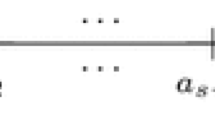Abstract
After introducing some extensions of a recently proposed probabilistic vector model for representing paired comparisons choice data, an iterative procedure for obtaining maximum likelihood estimates of the model parameters is developed. The possibility of testing various hypotheses by means of likelihood ratio tests is discussed. Finally, the algorithm is applied to some existing data sets for illustrative purposes.
Similar content being viewed by others
References
Akaike, H. On entropy maximization principle. In P. R. Krishnaiah (Ed.),Applications of statistics. Amsterdam: North-Holland, 1977, 27–41.
Amemiya, T. The maximum likelihood, the minimum chi-square and the nonlinear weighted least-squares method in the general qualitative response model.Journal of the American Statistical Association, 1976,71, 247–251.
Bechtel, G. G.Multidimensional preference scaling. The Hague: Mouton, 1976.
Bock, R. D., & Jones, L. V.The measurement of prediction of judgment and choice. San Francisco: Holden-Day, 1968.
Carroll, J. D. Individual differences and multidimensional scaling. In R. N. Shepard, A. K. Romney, & S. B. Nerlove (Eds.),Multidimensional scaling: Theory and Applications in the behavioral sciences (Vol. 1). New York: Seminar Press, 1972, 105–155.
Carroll, J. D. Models and methods for multidimensional analysis of preferential choice (or other dominance) data. In E. D. Lantermann & H. Feger (Eds.),Similarity and choice. Bern: Huber, 1980, 234–289.
Coombs, C. H.A theory of data. New York: Wiley, 1964.
De Soete, G. On the relation between two generalized cases of Thurstone's Law of Comparative Judgment.Mathématiques et Sciences humaines, 1983,21, 47–57.
Halff, H. M. Choice theories for differentially comparable alternatives.Journal of Mathematical Psychology, 1976,14, 244–246.
Heiser, W., & De Leeuw, J. Multidimensional mapping of preference data.Mathématiques et Sciences humaines. 1981,19, 39–36.
Jennrich, R. I., & Moore, R. H. Maximum likelihood estimation by means of nonlinear least squares.Proceedings of the American Statistical Association—Statistical Computing Section, 1975, 57–65.
Jones, L. V., & Jeffrey, T. E. A quantitative analysis of expressed preferences for compensation plans.Journal of Applied Psychology, 1964,48, 201–210.
Kruskal, J. B. Factor analysis and principal components. I. Bilinear models. In W. H. Kruskal & J. M. Tanur (Eds.),International encyclopedia of statistics. (Vol. 1). New York: The Free Press, 1978, 307–330.
McFadden, D. Quantal choice analysis: a survey,Annals of Economic and Social Measurement, 1976,5, 363–390.
Ramsay, J. O. Maximum likelihood estimation in multidimensional scaling.Psychometrika, 1977,42, 241–266.
Ramsay, J. O. The joint analysis of direct ratings, pairwise preferences, and dissimilarities.Psychometrika, 1980,45, 149–165.
Roskam, E. E., & Lingoes, J. C. MINISSA-I: Fortran IV(G) program for the smallest space analysis of square symmetric matrices.Behavioral Science, 1970,15, 204–205.
Scheffé, H. An analysis of variance for paired comparisons.Journal of the American Statistical Association, 1952,47, 381–400.
Schönemann, P. H., & Tucker, L. R. A maximum likelihood solution for the method of successive intervals allowing for unequal stimulus dispersions.Psychometrika, 1967,32, 403–417.
Sjöberg, L. Successive intervals scaling of paired comparisons.Psychometrika, 1967,32, 297–308.
Sjöberg, L. Choice frequency and similarity.Scandinavian Journal of Psychology, 1977,18, 103–115.
Sjöberg, L., & Capozza, D. Preference and cognitive structure of Italian political parties.Italian Journal of Psychology, 1975,2, 391–402.
Slater, P. The analysis of personal preferences.British Journal of Statistical Psychology, 1960,13, 119–135.
Takane, Y. A maximum likelihood method for nonmetric multidimensional scaling: I. The case in which all empirical orderings are independent—Theory.Japanese Psychological Research, 1978,20, 7–17.
Takane, Y. Maximum likelihood estimation in the generalized case of Thurstone's model of comparative judgement.Japanese Psychological Research, 1980,22, 188–196.
Takane, Y. Multidimensional successive categories scaling: a maximum likelihood method.Psychometrika, 1981,46, 9–18.
Takane, Y., & Carroll, J. D. Nonmetric maximum likelihood multidimensional scaling from directional rankings of similarities.Psychometrika, 1981,46, 389–405.
Thurstone, L. L. A law of comparative judgment.Psychological Review, 1927,34, 273–286.
Tucker, L. R. Intra-individual and inter-individual multidimensionality. In H. Gulliksen & S. Messick (Eds.),Psychological scaling: theory and applications. New York: Wiley, 1960, 155–167.
Wilks, S. S.Mathematical Statistics. New York: Wiley, 1962.
Author information
Authors and Affiliations
Additional information
The first author is “Aspirant” of the Belgian “Nationaal Fonds voor Wetenschappelijk Onderzoek.” Part of the research reported in this paper was done while the first author stayed at the L. L. Thurstone Psychometric Laboratory of the University of North Carolina at Chapel Hill supported by a CRB Fellowship of the Belgian American Educational Foundation, Inc. The authors wish to express their gratitude to Thomas S. Wallsten and Joseph B. Kruskal for helpful discussions.
Rights and permissions
About this article
Cite this article
De Soete, G., Carroll, J.D. A maximum likelihood method for fitting the wandering vector model. Psychometrika 48, 553–566 (1983). https://doi.org/10.1007/BF02293879
Received:
Revised:
Issue Date:
DOI: https://doi.org/10.1007/BF02293879




